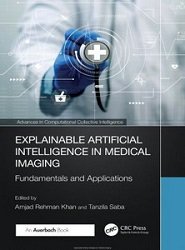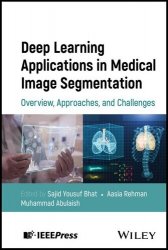 Название: Artificial Intelligence in Workplace Health and Safety: Data-Driven Technologies, Tools and Techniques
Название: Artificial Intelligence in Workplace Health and Safety: Data-Driven Technologies, Tools and TechniquesАвтор: Mohammad Yazdi
Издательство: CRC Press
Серия: Intelligent Data-Driven Systems and Artificial Intelligence
Год: 2025
Страниц: 127
Язык: английский
Формат: pdf (true), epub
Размер: 16.3 MB
In today's dynamic workplace environment, ensuring the safety and well-being of employees has never been more critical. This book explores cutting-edge technologies intersecting with workplace safety to deliver effective and practical results.
Artificial Intelligence in Workplace Health and Safety: Data-Driven Technologies, Tools and Techniques offers a comprehensive roadmap for professionals, researchers, and practitioners in work health and safety (WHS), revolutionizing traditional approaches through the integration of data-driven methodologies and Artificial Intelligence (AI). Covering the foundations and practical applications of data-driven WHS and historical perspectives to current regulatory frameworks, it investigates the key concepts of data collection, management, and integration. Through real-world case studies and examples, readers can discover how AI technologies such as Machine Learning, computer vision, and natural language processing (NLP) are reshaping WHS practices, mitigating risks, and optimizing safety measures. The reader will learn applications of AI and data-driven methodologies in their workplace settings to improve safety. With its practical insights, real-world examples, and progressive approach, this title ensures that readers are not just prepared for the future of WHS but empowered to shape it for better.
Machine Learning (ML): Machine learning, a core subset of AI, involves algorithms that enable systems to learn from and interpret data without explicit programming. In WHS, ML can be utilized to analyze vast amounts of incident data, workplace audits, and risk assessments. With the recognizing patterns and predicting potential hazards, ML aids in proactive safety management, reducing the likelihood of accidents before they occur.
Natural Language Processing (NLP): NLP enables computers to understand and interpret human language. In the area of WHS, NLP is instrumental in automating and improving communication between workers and safety management systems. It can analyze safety reports, worker feedback, and even social media to gauge safety sentiments within a workplace. Additionally, NLP is employed in training modules and emergency alerts, ensuring that crucial information is disseminated clearly and understood by all employees.
Chapter 1 discusses the historical progression from traditional safety management to the current era, where technologies such as Artificial Intelligence, Big Data, and the Internet of Things (IoT) play pivotal roles. This chapter aims to provide a foundational understanding of the technological underpinnings that make modern WHS systems possible and practical.
Chapter 2, “Optimizing Workplace Health and Safety: Strategic Data Collection and Management Techniques,” focuses on the practical aspects of data handling. I explore various data collection methods and the critical importance of data quality. The chapter delves into the nuances of data storage options and governance, highlighting the operational impacts and the strategic approaches necessary for enhancing WHS outcomes through effective data management.
Chapter 3, “Strategic Analytics for Proactive Workplace Safety Management,” examines the application of analytics in WHS. Starting with descriptive analytics, the chapter progresses to predictive and prescriptive analytics, demonstrating how these tools can forecast and mitigate potential safety issues. Through case studies, this section illustrates successful real-world analytics applications in improving safety measures.
Chapter 4, “Advanced Integration of Artificial Intelligence in Workplace Health and Safety Management,” discusses the transformative potential of AI in WHS. This chapter covers the broad spectrum of AI technologies reshaping risk assessment and incident response, from Machine Learning to robotics.
Finally, Chapter 5, “Navigating the Future: Technological Advancements and Implementation Challenges in Workplace Health and Safety,” looks ahead to the future of WHS. It explores the potential of augmented reality, robotics, and AI while considering the barriers to technology adoption, such as cultural resistance and high costs.
This text is written for professionals and practitioners seeking to enhance workplace safety through innovative technologies. This extends to safety professionals, HR personnel and engineers across different sectors.
Скачать Artificial Intelligence in Workplace Health and Safety: Data-Driven Technologies, Tools and Techniques
[related-news] [/related-news]
Комментарии 0
Комментариев пока нет. Стань первым!















